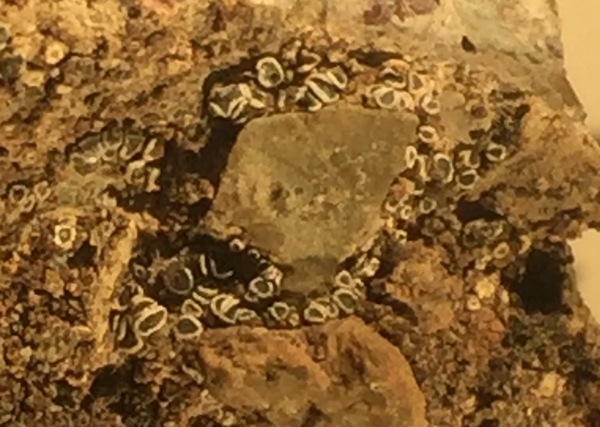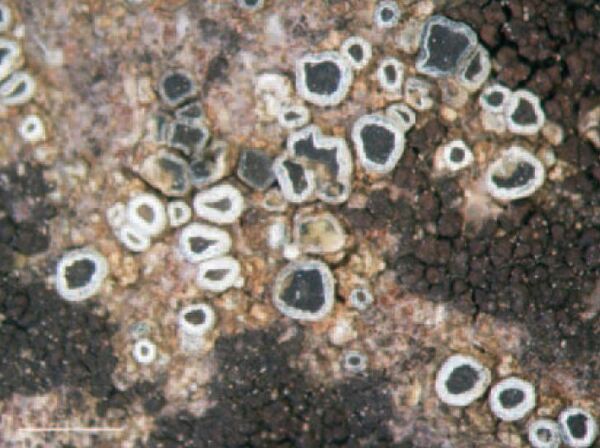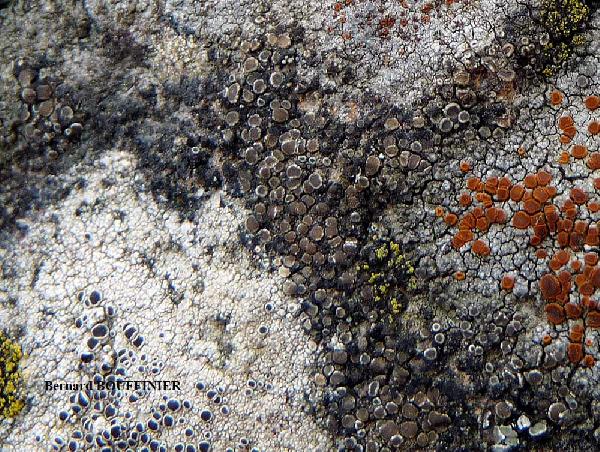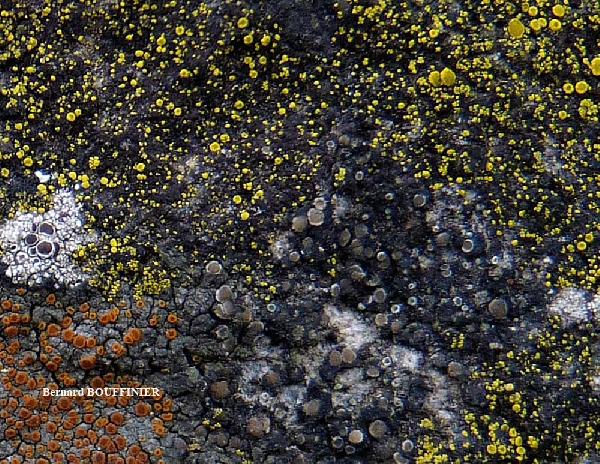Polyozosia invadens (H. Magn.) S.Y. Kondr., Lőkös & Farkas
n Kondratyuk & al., Acta Bot. Hung., 62, 1-2: 102, 2020. Basionym: Lecanora invadens H. Magn. - Lich. Central Asia: 87, 1940.
Synonyms: Lecanora meolansii B. de Lesd.; Myriolecis invadens (H. Magn.) Śliwa, Zhao Xin & Lumbsch
Distribution: N - Ven (TSB 19712), TAA (Nascimbene & al. 2022).
Description: Thallus crustose, endosubstratic or thinly episubstratic and poorly evident, often developed only around the apothecia, pale grey to greenish grey, often with a bluish hue. Apothecia lecanorine, sessile and often constricted at base, 0.3-0.8(-1) mm across, with a flat to convex, dark brown to patchily bluish black, epruinose or pruinose disc and an entire, smooth to slightly crenulate, pruinose, white to grey thalline margin. Thalline exciple 160-170 μm wide, corticate, the cortex 15-50 μm thick laterally, 45-60 μm thick at base, bluish in outer and upper parts, filled with granules (visible under polarized light) which are insoluble in K, and soluble in N, the medulla rich in algae; proper exciple prosoplectenchymatous, 10-15 μm wide; epithecium yellowish brown to olive green, often at least partly blue-green, the blue-green parts N+ purple, with sparse coarse granules between paraphyses tips, which are soluble in K and insoluble in N, and an epipsamma of small crystals located above the paraphyses tips, which are insoluble in K, but soluble in N; hymenium colourless, 45–65 μm high; paraphyses simple or sparingly branched, not markedly expanded at tips, easily made free in K; hypothecium colourless or pale yellow, 50-100 μm high. Asci 8-spored, elongate-clavate, very thin-walled, with a K/I+ blue, tall tholus penetrated by a faintly amyloid apical cushion, the wall K/I-, surrounded by a K/I+ blue outer layer, Lecanora-type. Ascospores 1-celled, hyaline, ellipsoid, 9-12 x 6-7.5 μm, less than 2 times as long as wide. Photobiont chlorococcoid. Spot tests: apothecial margin K- or K+ pale yellow, C- or C+ yellow, KC+ yellow, P-. Chemistry: vinetorin (5-chloro-3-O-methylnorlichexanthone), sometimes present only in traces. Note: on calciferous rocks in upland areas, often starting the life-cycle on other crustose lichens; certainly more widespread throughout the country. The species is closely related to P. semipallida.
Growth form: Crustose
Substrata: rocks
Photobiont: green algae other than Trentepohlia
Reproductive strategy: mainly sexual
paras crustose lichens
Commonnes-rarity: (info)
Alpine belt: rare
Subalpine belt: rare
Oromediterranean belt: rare
Montane belt: very rare
Submediterranean belt: absent
Padanian area: absent
Humid submediterranean belt: absent
Humid mediterranean belt: absent
Dry mediterranean belt: absent
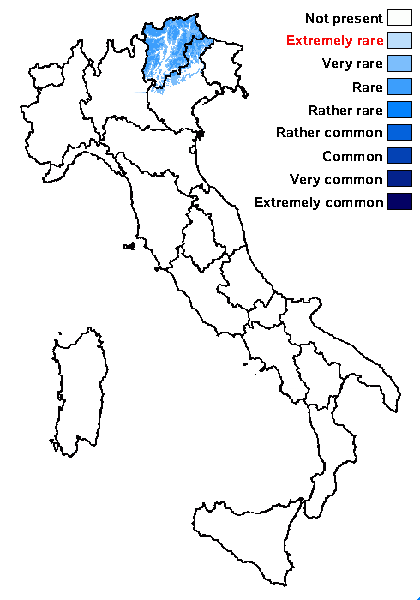
Predictive model
Herbarium samples
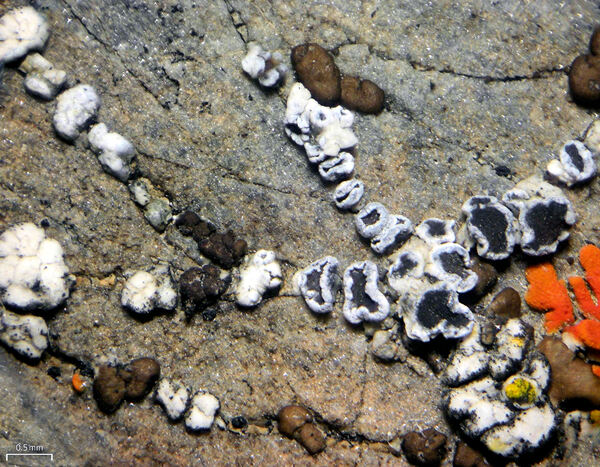
Jason Hollinger CC0 1.0 (Public-domain) Https://lichenportal.org/cnalh/collections/individual/index.php?occid=3764995
United States, Utah, Garfield County, Aquarius Plateau, ca. 10 km E of Johns Valley Rd. on FH 17 near head of Sweetwater Creek on slopes N of road 37.827 -111.899 +-50m. Elevation: 2650 m (8692ft)
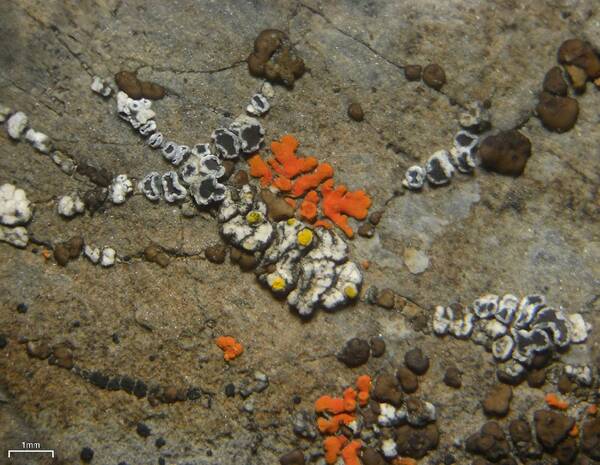
Jason Hollinger – CC0 1.0 (Public-domain) - Source: https://lichenportal.org/cnalh/collections/individual/index.php?occid=3764995
United States, Utah, Garfield County, Aquarius Plateau, ca. 10 km E of Johns Valley Rd. on FH 17 near head of Sweetwater Creek on slopes N of road 37.827 -111.899 +-50m. Elevation: 2650 m (8692ft)

Jason Hollinger – CC0 1.0 (Public-domain) - Source: https://lichenportal.org/cnalh/collections/individual/index.php?occid=3764995
United States, Utah, Garfield County, Aquarius Plateau, ca. 10 km E of Johns Valley Rd. on FH 17 near head of Sweetwater Creek on slopes N of road 37.827 -111.899 +-50m. Elevation: 2650 m (8692ft)

Courtesy Danièle et Olivier Gonnet - Source: https://www.afl-lichenologie.fr/Photos_AFL/Photos_AFL_M/Texte_M/Myriolecis_invadens.htm
France, session AFL 2014 - Alpes-de-Haute-Provence
Growth form: Crustose
Substrata: rocks
Photobiont: green algae other than Trentepohlia
Reproductive strategy: mainly sexual
paras crustose lichens
Commonnes-rarity: (info)
Alpine belt: rare
Subalpine belt: rare
Oromediterranean belt: rare
Montane belt: very rare
Submediterranean belt: absent
Padanian area: absent
Humid submediterranean belt: absent
Humid mediterranean belt: absent
Dry mediterranean belt: absent

Predictive model
| Herbarium samples |

Jason Hollinger CC0 1.0 (Public-domain) Https://lichenportal.org/cnalh/collections/individual/index.php?occid=3764995
United States, Utah, Garfield County, Aquarius Plateau, ca. 10 km E of Johns Valley Rd. on FH 17 near head of Sweetwater Creek on slopes N of road 37.827 -111.899 +-50m. Elevation: 2650 m (8692ft)

Jason Hollinger – CC0 1.0 (Public-domain) - Source: https://lichenportal.org/cnalh/collections/individual/index.php?occid=3764995
United States, Utah, Garfield County, Aquarius Plateau, ca. 10 km E of Johns Valley Rd. on FH 17 near head of Sweetwater Creek on slopes N of road 37.827 -111.899 +-50m. Elevation: 2650 m (8692ft)

Jason Hollinger – CC0 1.0 (Public-domain) - Source: https://lichenportal.org/cnalh/collections/individual/index.php?occid=3764995
United States, Utah, Garfield County, Aquarius Plateau, ca. 10 km E of Johns Valley Rd. on FH 17 near head of Sweetwater Creek on slopes N of road 37.827 -111.899 +-50m. Elevation: 2650 m (8692ft)

 DOLICHENS
DOLICHENS
